HUDSON, Ann Owen & BARNES, Samuel
(1834 - 1893) (c.1826 -1903)

Ann Owen Hudson was born to John Hudson and his new wife Jane (previously Valler nee Williams) on 27 April 1834 and baptized 19 October 1834, St Pancras, Middlesex, UK. The home address at that time is Little Guildford Street. And what could be the reason for the middle name of the daughter Ann...? Owen is a rather unusual name for a girl unless it represents someone further back in the family line. (Maybe they were hoping for another son...?) More food for thought!
Ann arrived South Australia in 1838 with her mother Jane and brother James, together with half siblings William Roope, Jane and Sarah Elizabeth Valler.
Nothing is known of her movements between that time and 1850, but she obviously left South Australia at some stage and made her way to Tasmania for out of the blue an entry for a Marriage in Launceston relating to her came to light. There are entries on "Index to Convict Applications For Permissions to Marry 1829-1857" for Samuel Barnes, Ticket of Leave convict, dated 2 July and 13 August 1850 who arrived on the ship "CHINA".
Samuel was born c.1826, was tried at Southampton Assizes 10 July 1845, convicted for burglary (stealing spoons etc) and was given a sentence of 7 years. He was transported on the convict ship "CHINA", which embarked Woolwich, London 26 December 1845 and arrived Van Diemen's Land (Tasmania) on 16 May 1846.
He also served time on Norfolk Island departing from there on "LADY FRANKLIN" in August 1847, arriving VDL 22 September 1847.
He received his Free Certificate on 16 July 1862 - his convict record states he could read and write a little - his occupation showed him to be a Baker.
He married Ann Owen Hudson on 16 September 1850 accordingto the Rites and Ceremonies of the United Church of England and Ireland, by Banns with Consent of Government Minister. The marriage took place at St John's Church in Launceston, Tasmania.
 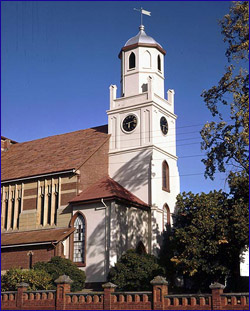
LEFT: St John's Church (Hobart Town Almanack 1830 - RIGHT: Photo 1970
Information and 1970 photo “© Organ Historical Trust of Australia www.ohta.org.au - used with permission October 2010”.
A LITTLE ABOUT THE CHURCH
By 1824 Launceston had become the base for whalers, whose stations were at Encounter Bay, and Portland Bay, and for the men stripping wattle bark at Westernport. Lieut.-Governor Sorell made it the official headquarters of the northern settlement. On 28 December 1824 Lieut.-Governor Arthur laid the foundation stone of St Johnís Church Launceston on Land that Chaplain Samuel Marsden had blessed.
It had been intended that St Johnís should be a replica of St. Davidís Hobart Town, but its size was arbitrarily reduced to what was considered adequate for the smaller settlement thus adversely affecting its proportions. The church, of Georgian design, was constructed of locally made bricks marked with the broad arrow, and built by convicts under the supervision of David Lambe, who had been appointed colonial architect in June 1824. St Johnís was first used, in unfinished condition, on 16 December 1825 and was capable of seating 550 people in its nave and galleries. It was dedicated by Archdeacon Thomas Hobbes Scott on 6 March 1828. Two years later the tower with its octagonal turret was completed and in 1835 a clock and bell were installed in it.
During the 20th century the appearance of the church, both within and without, has been considerably altered. A master plan was prepared by Alexander North to enlarge the church and between 1901 and 1911 the chancel was widened by three meters, transepts were added, and provision made for a massive tower at the crossing. In 1938 the nave was reconstructed, the original walls being kept intact but raised in height and faced with new brickwork. It is worth noting that it is no longer intended to implement the remainder of the masterplan which would have meant replacing the tower and vestries at the western end, the only visible remaining part of the original church, by twin towers linked with a great arch.
As it now stands, the church presents an unusual construction of two very different architectural styles. The severe simplicity of the original nave with its low aisles and high clerestory and squat tower, surmounted by an octagonal turret, contrasts with the Gothic exuberance of the transepts and chancel which are constructed of red Victorian bricks and golden Patersonian sandstone with heavy bluestone foundations. Its final appearance will depend very greatly upon the height of the central tower with which the original tower and turret could be in competition.
|
Samuel and Ann Barnes had a number of children all born in Launceston - Sarah Ann 6 September 1851, Samuel 20 September 1853, Elizabeth Ann 26 February 1855, Charlotte 27 February 1858, Samuel George 3 May 1861, Alfred 9 August 1867, Rosina 8 December 1869, William Henry 10 December 1871, Lillian 16 March 1874, Charles 25 February 1876 and Annie 21 June 1878. Of these 11 children deaths have been found for Samuel (baby) in 1854 and Sarah Ann aged 2 in 1854.
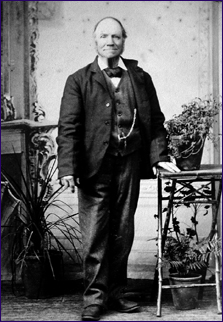 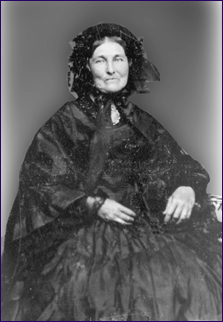
Samuel Barnes and his wife Ann Owen Barnes nee Hudson
Photos courtesy M Knight per grandson of Annie Harrex nee Barnes (daughter of Ann Owen Barnes)
Samuel had a shop and house in Kings Meadows, and Land 5 acres 20 Pounds at Youngtown. Detail from Hobart Gazette under the District of Selby. (Per M Marshall, Tasmanian contact.)
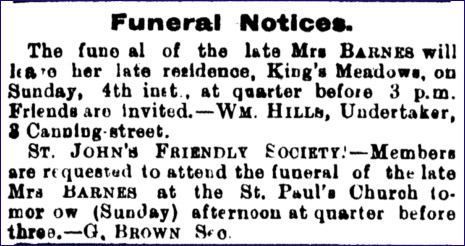
Funeral Notice Launceston Examiner
3 June 1893
Ann Owen Barnes nee Hudson died in Evandale aged 59 on 1 June 1893. Her burial service was conducted at St Paul's Anglican Church, Launceston on 4 June. She was buried at the Charles St. Cemetery, Launceston.
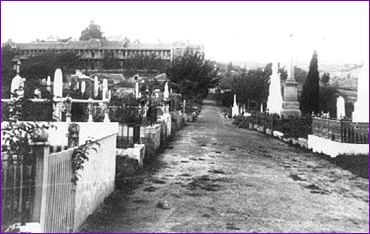
Charles St. Cemetery circa 1880
(from the collections of the Launceston Library)
State Library of Tasmania
|

Ockerby Gardens
(formerly Charles St. General Cemetery)
Launceston - 2006
|

STONE FACADE: The Mortuary Building
Charles Street, Launceston
(about 1867)
Examiner News - 23 October 2002
Images courtesy M Marshall
Her husband Samuel married Agnes McClaren four months later; he died in Launceston 17 August 1903.
A fellow researcher stated that [quote] unfortunately the Charles Street General Cemetery was demolished in the early 1940s. According to Anne Green's book "Places of Management, Mentoring & Medicine in Launceston", there were 600 to 700 headstones. The graves seem to have been left there, although relatives had the option of removing headstones if they wished. I don't know what happened to the headstones that were not removed by relatives. Perhaps the Launceston City Council might have some further information? Sometimes headstones from demolished cemeteries were moved to Carr Villa, but I could not find anyone matching Ann's description on their website index. [end quote]
Records show that Ann's half-sister Jane Valler also made her home in Tasmania. Maybe one day we'll learn the 'how and when' of them living their lives in a different part of the country to their siblings......
Ann Owen Hudson - born in London, died Tasmania - two places a world apart.......
|







